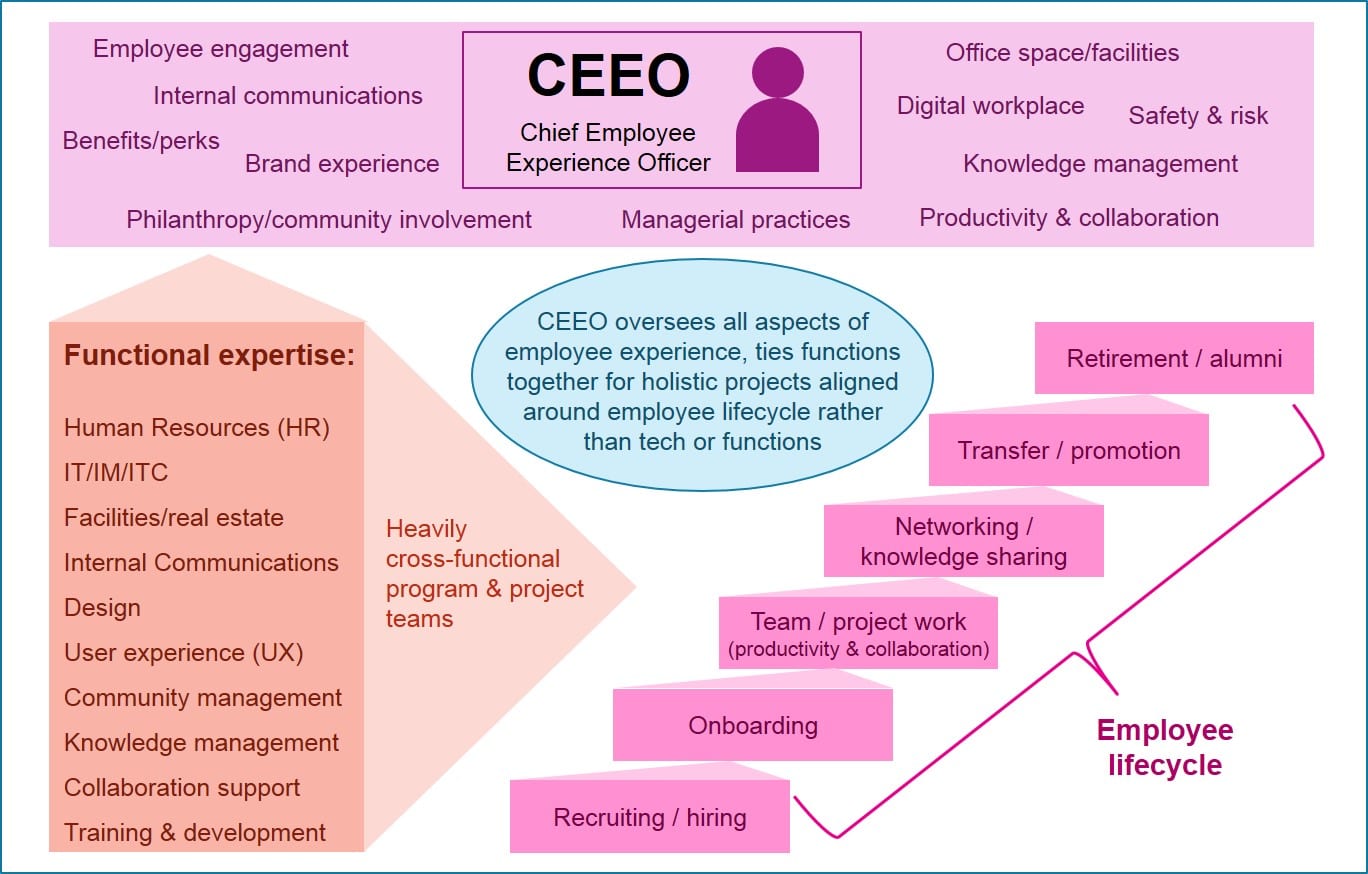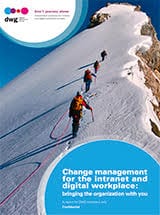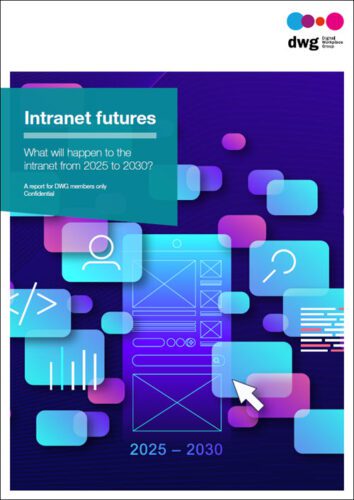Do you have a Chief Employee Experience Officer (CEEO) leading your digital workplace?

Two common success factors for digital workplace projects are: 1) cross-functional teams that work across/against organizational silos; and 2) a focus on the user experience. So why not restructure the organization to incorporate these approaches?
Large organizations are struggling to keep up
If you read the kind of news I do, you get the sense that large organizations are struggling in many ways to adapt to changing employment patterns, shifting worker populations and new types of work. This could result in a higher turnover rate than normal and it is estimated that It costs approximately $15,000 to replace a single employee for any company.
Common challenges that capture the headlines include issues such as:
- Shortening employee tenure, higher turnover rates.
- More competition for talented workers.
- Changes to the nature of work and the knowledge needed.
- Rapidly changing markets and competitive landscapes.
- A shortage of talent in many knowledge worker roles.
- Millennials’ unmet expectations around work and digital tools.
- (In the US) Ivy league talent shifting their focus from Wall Street to Silicon Valley and startups.
Focus on this too much and the outlook seems bleak for large organizations, both the more traditional ones and the newer tech outfits.
The digital workplace expectation gap
We at DWG are extra cognizant of the deficits of digital workplaces and how they impact organizations. Poor digital working experiences tend to be the norm and the issues manifest in several ways:
- De-prioritization for digital workplace investment.
- Lack of adequate skills and resources for digital workplace teams.
- The gap between consumer and workplace technology experience.
- Millennial disenchantment with technology within large organizations.
- Resulting productivity and employee engagement debt.
In this modern age of complex, globally dispersed workforces, digital workplaces can shape the experience of work even more than physical workplaces. But the digital design of work is frequently frustrating and poorly thought out, often with no intentional design involved at all.
Executives may not even recognise the massive deficits in productivity and employee satisfaction because the standards are just so low.
Siloed organizational functions may be the problem
There are many, many reasons why digital workplaces are in such a bad condition and why digital workplace projects and programmes so often fall short of expectations.
One well-known issue is the non-collaborative way in which many organizations’ operational divisions operate. Often, functions like IT, HR, Facilities, Internal Communications and others report upwards to a Chief Operations Officer (COO). And often each of these vertical functions operates as if in a vacuum, with the greatest hurdle being simply coordinating with other functions within their own division. Sound familiar?
In recent years, report after report has focused on the dwindling strategic value of HR, IT and other operational functions, the changing nature of Internal Communications, and more.
A new report from Quora Consulting brings this issue into sharp relief. The research report, Time’s up for IT and Property Directors, paints a dark, yet commonly experienced, picture of operational functions in large organizations.
Headlines from the report include:
- Business leaders have lost patience with their support functions and are seizing control of over 75% of IT and Property budgets.
- Workforces are distracted by a torrent of: workplace changes; irrelevant technologies; and unstructured HR programmes, each delivered in splendid isolation.
- Staff are interrupted and switch tasks every 3 minutes – once distracted it takes half an hour to resume the original task.These interruptions sap 42% of the working day.
- 75% of the brightest talent are leaving their organizations inside 2 years, citing disillusionment with the calibre of management and frustration with the unproductive, poorly optimized workplace design.
It seems that the last century’s legacy of organizational design may be reaching a breaking point. Intranet and digital workplace teams have felt this for a while.
Common intranet and digital workplace symptoms
In my realm of work, intranet and digital workplace teams have been encountering the limitations of organizational design for years. A few examples include:
- IT-run intranets often lack resources for usability, training and change management.
- Internal Communications-run intranets often look like digital magazines with a lack of focus on productivity.
- There is a total lack of support for using collaborative tools because organizations have seen them as purely technology issues.
- Only some organizations have incorporated “Community Manager” roles to support knowledge sharing and online communities of practice.
- Most large organizations are entirely missing user experience design (UXD) capabilities for their digital workplace projects.
- Intranets struggle to find departmental ownership because their value spans multiple functions.
- Intranet projects are often put on hold due to teams constantly being moved and restructured, and changes in divisional priorities.
Further examples abound. All of these examples, though, highlight the issues raised in the Quora report and plenty of other recent research.
Cross-functional coordination – a key to digital workplace success
On the flip side, the DWG report on Digital Workplace Fundamentals: The integrated approach found that strong cross-functional coordination was a key theme among successful digital workplace projects. The case studies examined in this report collectively suggest that effective digital workplace projects rely on cross-functional teams at all project levels, from the steering group down to implementation teams.
The Quora Consulting and DWG report together powerfully make the point: Siloed operational structures may cause more problems for large organizations than they solve and the time for change is now.
Further success factors: a focus on user experience
Another key theme that we see in the course of DWG’s work is that a strong focus on user experience (UX) leads to better results, and the most sophisticated digital workplace teams have built up strong UXD capabilities.
For example, if you ask the Mayo Clinic digital workplace team about any aspect of their intranet, they’ll start their response with: “Well, our user research shows that…” Observational, research-based data underpins many of their strategic and tactical intranet design decisions.
Similarly, the winners of the Intranet Innovation Awards as well as those featured in the Nielsen Norman Group Intranet Design Annual have almost all employed rich UXD practices.
While we’ve seen an increasing focus on UXD in the intranet and digital workplace realm, it’s still not the norm.
So, heavily siloed operational structures and a lack of focus on user experience are hindering the advancement of digital workplaces and the broader adaptation of large organizations to a changing world of work. What can we do about that?
Employee experience as the guiding light
Now it’s time to make my core argument for the importance of positioning “employee experience” as the focus of operational and support functions.
I’ll start with a story: I love General Tso Chicken, the sweet and spicy Chinese dish (actually, it’s an American-Chinese-restaurant dish that is almost entirely unknown in China). I recently wanted to try the dish from a Chinese restaurant near my house. The moment I walked through the door of the restaurant I smelled industrial cleaner. The kind of smell you get when an old dirty room has just been washed for the first time in a while. The first whiff of that smell and I substantially lowered my expectations and decided never to return to the restaurant. And, of course, it was the worst General Tso Chicken I’ve ever had.
But even if you go to a good restaurant, a rude hostess or waiter can set a negative tone that colours the rest of your experience. One negative experience can cast a pall on an entire brand, turning off a customer – or employee – permanently.
Apple has become the world’s leading luxury brand by paying tremendous attention to every aspect of the experience. From the design of the box your iPhone comes in, to the ambiance of their stores, to the attention you get at the Genius Bar – and that’s before you even get on to the products and software interfaces.
In a world of increasingly intense competition for talented knowledge workers, there is a stronger need than ever to craft positive employee experiences. Such experiences begin even before the recruiting and hiring process, when future employees first encounter the brand as a service or product. Once hired, their experience is further influenced by the physical space, digital tools, managerial practices and many other factors.
Any organization seeking to build compelling experiences of employment that will attract, retain and bring back good people, needs to seriously consider taking a holistic approach to managing the employee experience.
Organizations that vie for spots on “best places to work” lists, as well as large tech companies that provide outlandishly cool offices, are striving to create excellent experiences of employment. But are these and other large organizations doing so in a coordinated, aligned way?
With that non-rhetorical question I arrive at the core idea behind this post.
The new concept: the Chief Employee Experience Officer (CEEO)
Without further ado I’d like to propose the concept of the Chief Employee Experience Officer, and a large-scale rejiggering of operational design.

This new role would thoroughly alter the way operational functions are perceived and work together. It would shift executive responsibilities from delivering rather narrow functions to offering coordinated, cohesive, aligned employee programmes.
In the sales and marketing world we’ve seen a big shift to focus on “customer experience”. Executives in these areas recognize how important the entirety of the brand experience is and focus on managing that rather than merely concentrating on the functions.
The world of internal operations is ready for this same shift.
New structure: agile, collaborative functional centres
The idea of a CEEO doesn’t require you to jettison all the usual operational functions. But it does require them to be re-imagined as capabilities or centres of excellence that can be brought into cross-functional teams.
The areas of capability should include some traditional operational functions, such as HR, and some that are often lacking, such as Community Management.
Here is my fleshed out list of operational functions:
- Human Resources (HR)
- IT/IM/ITC
- Facilities/Real Estate
- Internal Communications
- Design
- User Experience (UX)
- Community Management
- Knowledge Management
- Collaboration Support
- Training & Development
Each of these areas of practice can have an important role to play in shaping employee programmes, services and technology systems. But they should all work together under the umbrella of “employee experience”.
Alignment around the employee lifecycle
Next, the work of the Employee Experience division should be organized not around operational functions or technology solutions, but around the employee lifecycle.
Here’s my simple model of the employee lifecycle, from the above diagram:
- Recruiting
- Hiring
- Onboarding
- Team / project work (productivity & collaboration)
- Networking and knowledge sharing
- Transfer / promotion
- Retirement / alumni.
For projects related to each stage of the employee lifecycle, all the right functional capabilities can be brought into a collaborative team.
This approach may be familiar and is approximately how some organizations work today. The main difference, though, is that current organizational structures don’t lend themselves to this approach. Organizations that already work in this way have had to very intentionally break out of the limitations of their siloed structures and create new ways of coordinating and collaborating.
This new approach suggests that organizations realign their structures and approach around known success factors, rather than keeping the old structures in place and overcoming them.
The culture and communications caveat
At this point I should add a wee caveat with two parts:
- An organization can take the approach I’ve advocated here without changing its structure, if it has the user-focused, collaborative culture required; but conversely
- An organization that makes the structural changes but doesn’t improve its collaboration and communication flows likely won’t succeed with this approach.
One of my favourite management articles of all time came from the June 2008 issue of the Harvard Business Review. Titled The Secrets to Successful Strategy Execution, its main research conclusion was that changing organizational structures is actually a third priority, after: 1) clarifying decision rights; and 2) ensuring that information flows where it is needed.
That article suggests that only after decision rights and information flow have been aligned to a strategy should any major restructuring come into play.
The point here is that restructuring on its own is not a solution. This doesn’t mean that the proposed new operational structures I’ve put forward won’t work, but simply that they won’t work if other key strategy execution elements are left to blow in the wind.
Just an idea, but maybe an important one
As a final point, I should note that I personally have done zero proper research to back up the proposal in this article. While I’m a long-time student of organizational development, nobody has ever called me expert in it (unless they’ve been doing so behind my back).
Rather, through my work with DWG I have a front-row seat from which to watch the digital workplace industry change and mature. It’s my job to recognize and highlight key themes and concepts emerging from this evolution, which is what this article aims to do.
Will the idea of a CEEO catch fire and change how large organizations work? Maybe not. But perhaps the time is ripe.
But the core idea of shifting operational functions to align around employee experience is sound. Of that I’m sure. I may not be able to decipher exactly what the wind is saying, but I know in what direction it’s blowing.
Related research
[one_half]
[/one_half] [one_half_last]
[/one_half_last]
Categorised in: Digital employee experience


